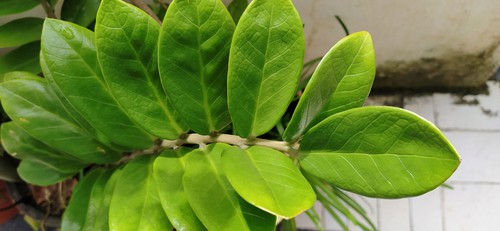A ZZ plant is a popular houseplant that is known for its attractive, glossy foliage and low maintenance requirements. However, even with the best care, ZZ plants can sometimes become sickly and begin to die. It is important to know how to identify a dying ZZ plant and how to revive it to ensure its survival.
Identifying a dying ZZ plant can be tricky, but there are a few telltale signs to look out for. Yellowing or browning leaves, drooping stems, and a foul smell emanating from the soil are all indicators that your ZZ plant is in trouble. If you notice any of these symptoms, it is important to act quickly to save your plant.
Common causes of a dying ZZ plant include overwatering, underwatering, lack of sunlight, and root rot. Reviving a dying ZZ plant involves identifying the cause of the problem and taking corrective action.
This may involve adjusting watering habits, repotting the plant, or providing more light. With the right care, a dying ZZ plant can often be brought back to life and thrive once again.
Key Takeaways
- Identifying a dying ZZ plant is crucial for its survival.
- Common causes of a dying ZZ plant include overwatering, underwatering, lack of sunlight, and root rot.
- Reviving a dying ZZ plant involves identifying the cause of the problem and taking corrective action.
Identifying a Dying ZZ Plant

If you suspect that your ZZ plant is dying, it is important to identify the problem as soon as possible to save it. Here are some common signs to look for:
1. Recognizing Yellowing Leaves
Yellow leaves are one of the most common signs of a dying ZZ plant. This can be caused by overwatering or underwatering, lack of nutrients, or pests. If the yellowing leaves are accompanied by brown spots or pale leaves, it may be a sign of a more serious issue.
2. Spotting Brown Leaves
Brown leaves on a ZZ plant can be caused by a variety of factors, including overwatering, underwatering, lack of nutrients, or pests. If the brown leaves are accompanied by black spots or a leggy appearance, it may be a sign of a more serious issue.
3. Understanding Drooping Leaves
Drooping leaves can be a sign of underwatering, overwatering, or root rot. If the drooping leaves are accompanied by brown tips or pale leaves, it may be a sign of a more serious issue.
4. Detecting Scorched Leaves
Scorched leaves are a sign that your ZZ plant is receiving too much direct sunlight. This can cause the leaves to turn brown and dry out. Move your plant to a location with less direct sunlight to prevent further damage.
Dying ZZ Plant – 7 Common Problems

ZZ plants are known for their hardiness and ability to survive in low-light conditions, but they are not invincible. There are several factors that can contribute to a ZZ plant dying, and it is important to identify and address them promptly to save the plant.
1. Effects of Overwatering
Overwatering is one of the most common causes of a dying ZZ plant. ZZ plants prefer to be watered only when the soil is completely dry, and overwatering can lead to root rot and other issues.
Signs of overwatering include yellowing leaves, drooping stems, and brown tips. If a ZZ plant is overwatered, it is important to allow the soil to dry out completely before watering again.
2. Impact of Underwatering
Underwatering can also cause a ZZ plant to die. ZZ plants need to be watered regularly, and if they are not given enough water, they may become dehydrated and wilt. Signs of underwatering include yellowing leaves, slow growth, and stunted growth. If a ZZ plant is underwatered, it is important to water it thoroughly and regularly.
3. Role of Soil Quality
The quality of the soil can also impact the health of a ZZ plant. ZZ plants prefer well-draining soil that is rich in nutrients. If the soil is too compacted or lacks nutrients, the plant may struggle to grow and may eventually die. It is important to use high-quality soil and to fertilize the plant regularly to ensure its health.
4. Influence of Light Conditions
ZZ plants can survive in low-light conditions, but they still need some sunlight to thrive. If a ZZ plant is kept in a room with no windows or in a dark corner, it may struggle to grow and may eventually die.
Signs of inadequate light include slow growth and yellowing leaves. It is important to place a ZZ plant in a room with adequate sunlight or to use artificial lighting if necessary.
5. Importance of Temperature and Humidity

ZZ plants prefer warm and humid conditions, and if they are kept in a room that is too cold or too dry, they may struggle to grow and may eventually die.
Signs of low humidity include wilting leaves and slow growth. It is important to keep a ZZ plant in a warm and humid room, and to mist the leaves regularly to provide additional moisture.
6. Understanding Root Rot
Root rot is a fungal disease that can occur when a ZZ plant is overwatered or when the soil does not drain properly. Signs of root rot include brown, mushy roots and a foul smell. If a ZZ plant has root rot, it may be necessary to repot the plant in fresh soil and to remove any affected roots.
7. Impact of Fungal Diseases
Fungal diseases can also cause a ZZ plant to die. These diseases can be caused by poor soil quality, overwatering, or inadequate light.
Signs of fungal diseases include yellowing leaves, brown spots, and slow growth. If a ZZ plant has a fungal disease, it may be necessary to treat the plant with a fungicide and to improve its growing conditions.
Reviving a Dying ZZ Plant
ZZ plants are known for their ability to thrive even in low light conditions and neglect. However, if you notice your ZZ plant wilting or showing signs of distress, it may be dying. Reviving a dying ZZ plant is possible with the proper care and attention. Here are some tips to help you save your plant:
1. Watering and Fertilizing Properly
One of the most common reasons for a dying ZZ plant is overwatering. ZZ plants need to be watered about once a week, and they like their soil to be allowed to dry out completely between waterings.
If you’re watering your plant more often than that, or if the soil is always damp, it could be causing your plant to rot. On the other hand, if you’re not watering your ZZ plant enough, it could be causing the leaves to turn yellow and fall off.
To revive a dying ZZ plant, make sure you’re watering it properly. Water the plant thoroughly, but allow the soil to dry out completely before watering again. ZZ plants don’t need a lot of fertilizer, but they do benefit from being fertilized once or twice a year. Use a balanced fertilizer and follow the instructions on the package carefully.
2. Providing Suitable Light Conditions

ZZ plants can survive in low light conditions, but they do best in bright, indirect light. If your ZZ plant is not getting enough light, it could be causing the leaves to turn yellow and fall off. On the other hand, if your ZZ plant is getting too much direct sunlight, it could be causing the leaves to burn and turn brown.
To revive a dying ZZ plant, make sure it’s getting the right amount of light. Place the plant in a bright, indirect light location, such as near a north-facing window. If your ZZ plant is getting too much direct sunlight, move it to a location where it will receive less sunlight.
3. Maintaining Ideal Temperature and Humidity
ZZ plants prefer warm temperatures between 60 and 75 degrees Fahrenheit. If the temperature drops below 60 degrees, it could cause the plant to go into dormancy and stop growing. On the other hand, if the temperature is too high, it could cause the leaves to wilt and turn yellow.
To revive a dying ZZ plant, make sure it’s in a location with the right temperature. If the temperature is too low, move the plant to a warmer location. If the temperature is too high, move the plant to a cooler location. ZZ plants also prefer humidity levels between 40 and 60 percent. If the air is too dry, it could cause the leaves to turn brown and fall off.
4. Repotting the ZZ Plant
If your ZZ plant is in distress, it could be because it’s outgrown its current pot. ZZ plants prefer to be in well-aerated, well-draining soil. If the soil is compacted and not allowing for proper drainage, it could be causing the plant to rot.
To revive a dying ZZ plant, repot it in a new pot with fresh, well-aerated soil. Make sure the new pot has a drainage system to allow excess water to escape. When repotting, be gentle with the plant’s rhizome, as it’s delicate and can be easily damaged.
5. Pruning and Trimming the Plant
If your ZZ plant is dying, it may benefit from pruning and trimming. Remove any yellow or brown leaves, as they’re no longer healthy and can be a source of infection for the rest of the plant. You can also trim any stems that are overgrown or leggy.
To revive a dying ZZ plant, prune and trim it as necessary. Make sure to use clean, sharp scissors to avoid damaging the plant further.
Reviving a dying ZZ plant requires patience and proper care. By following these tips, you can save your plant and keep it healthy for years to come.
Preventing Future Issues

To prevent future issues with ZZ plants, it is important to provide proper care and maintenance. ZZ plants are relatively easy to care for, but they still require some attention to thrive.
One of the most important aspects of ZZ plant care is ensuring that they receive the proper amount of water. Overwatering can cause root rot, while underwatering can lead to dry, crispy leaves.
ZZ plants prefer to be watered thoroughly but infrequently, and they like their soil to dry out completely between waterings. It is also important to ensure that the pot has adequate drainage holes to prevent water from pooling at the bottom.
In addition to proper watering, ZZ plants need to be placed in an area with bright, indirect light. Too much direct sunlight can scorch the leaves, while too little light can cause the plant to become leggy and weak. Grow lights can be used to supplement natural light if necessary.
ZZ plants also benefit from regular fertilization and occasional trimming. Fertilizer should be applied during the growing season, and pruning can help to promote new growth and prevent leaf drop.
It is important to keep an eye out for any signs of stress or neglect, such as browning leaves or a root-bound plant. Addressing these issues promptly can help to prevent more serious problems down the line.
Frequently Asked Questions
How do you revive a ZZ plant?
If a ZZ plant is dying, there are several things that can be done to revive it. First, check the soil moisture level and adjust watering accordingly. ZZ plants prefer to be watered once a week, and the soil should be allowed to dry out completely between waterings.
If the soil is too wet, the plant may be suffering from root rot. In this case, repotting the plant in fresh soil and trimming any diseased roots may help. Additionally, ZZ plants benefit from bright, indirect light and occasional fertilization.
What causes ZZ plant leaves to fall off?
There are several reasons why ZZ plant leaves may fall off. Overwatering is a common cause, as it can lead to root rot and subsequent leaf drop.
Underwatering can also cause leaves to fall off, as the plant may shed leaves to conserve water. Other causes include low light levels, pest infestations, and nutrient deficiencies.
What are the signs of overwatering a ZZ plant?
Signs of overwatering in a ZZ plant include yellowing leaves, mushy stems, and a foul odor emanating from the soil. The plant may also exhibit slow or poor growth and develop root rot.
How can you tell if a ZZ plant is underwatered?
Symptoms of underwatering in a ZZ plant include drooping leaves, brown tips, and slow growth. The soil may also be dry to the touch.
What are the symptoms of ZZ plant root rot?
Symptoms of ZZ plant root rot include yellowing leaves, mushy stems, and a foul odor emanating from the soil. The plant may also exhibit slow or poor growth and develop blackened or mushy roots.
What is the best way to propagate ZZ plants?
ZZ plants can be propagated through division or stem cuttings. To propagate through division, carefully separate the plant into smaller sections, ensuring that each section has at least one healthy rhizome and several leaves.
To propagate through stem cuttings, cut a stem near the base of the plant and allow it to dry for several hours. Then, plant the cutting in moist soil and keep it in bright, indirect light.

Hey, I’m Lisa and I’ve been an avid gardener for over 30 years. I love writing, talking and living in the garden! Feel free to connect with me on my socials below


